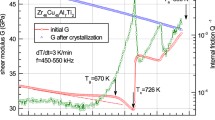Shear stress relaxation is studied in glasses of similar chemical composition of the system Pd – Cu – Ni – P, whose melts differ considerably with respect to glass-forming capacity. It is demonstrated that glass, whose melt develops considerable glass-forming capacity, always relaxes more slowly. The result obtained is discussed in connection with the possible reasons for glass formation and homogeneous plastic flow of metallic glasses.



Similar content being viewed by others
References
A. Inoue and A. Takeuchi, “ Recent development and application products of bulk glassy alloys,” Acta Mater. 59, 2243–2267 (2011).
J. H. Na, M. D. Demetriou, and W. D. Johnson, “ Fragility of iron-based glasses,” Appl. Phys Lett., 99, 161902 (2011).
S. Mukherjee, J. Schroers, W. L. Johnson, and W. -K. Rhim, “ Influence of kinetic and thermodynamic factors on the glass-forming ability of zirconium-based bulk amorphous alloys,” Phys. Rev. Lett., 94, 245501 (2005).
S. Guo, Z. P. Lu, and C. T. Liu, “Identify the best glass forming ability,” Intermetallics, 18, 883–888 (2010).
Z. Long, G. Xiec, H. We, et al., “On the new criterion to assess the glass-forming ability of metallic alloys,” Mater. Sci. Eng. A, 509, 23–30 (2009).
A. L. Greer and E. Ma, “Bulk metallic glasses: at the cutting edge of metals research,” Mater. Res. Bull., 32, 611–615 (2007).
Y. Li, G. Guo, J. A. Kalb, and C. V. Thompson, “Matching glass-forming ability with the density of the amorphous phase,” Science, 322, 1816–1819 (2008).
F. Spaepen, “Homogeneous flow of metallic glasses: a free volume perspective,” Scr. Mater., 54, 363–367 (2006).
G. V. Afonin, S. V. Khonik, R. A. Konchakov, et al., “ Structural relaxation and related viscous flow of Zr – Cu – Al-based bulk glasses produced from the melts with different glass-forming ability,” Intermetallics, 19, 1298–1305 (2011).
J. Schroers and W. L. Johnson, “Extremely low critical cooling rate measured on dispersed Pd43Cu27Ni10P20,” Appl. Phys. Lett., 80, 2069 (2002).
V. A. Khonik, “The kinetics of irreversible structural relaxation and rheological behavior of metallic glasses under quasi-static loading,” J. Non-Cryst. Solids, 296, No. 3, 147–157 (2001).
O. P. Bobrov, V. A. Khonik, S. A. Lyakhov, et al., “Shear viscosity of bulk and ribbon glassy Pd40Cu30Ni10P20 well below and near the glass transition,” J. Appl. Phys., 100, 033518 (2006).
I.-R. L., G. P. Görler and R. Willnecker, “Specific volume of glass-forming liquid Pd43Cu27Ni10P20 and related thermodynamic aspects of the glass transition,” Appl. Phys. Lett., 80, 4532 (2002).
G. J. Fan, J. F. Löffler, R. K. Wunderlich, and H.-J. Fecht, “Thermodynamics, enthalpy relaxation and fragility of the bulk metallic glass-forming liquid Pd43Ni10Cu27P20,” Acta Mater., 52, 667–674 (2004).
W. H. Wang, “The elastic properties, elastic models and elastic perspectives of metallic glasses,” Prog. Mater. Sci., 57, 487–656 (2012).
Z. F. Zhao, P. Wen, W. H. Wang, and C. H. Shek, “Observation of secondary relaxation in a fragile Pd40Ni10Cu30P20 bulk metallic glass,” Appl. Phys. Lett., 89, 071920 (2006).
Q. K. Jiang, X. D. Wang, X. P. Nie, et al., “ Zr – (Cu, Ag) – Al bulk metallic glasses,” Acta Mater., 56, 1785–1796 (2008).
A. V. Granato, “Interstitialcy model for condensed matter states of face-centered-cubic metals,” Phys. Rev. Lett., 68(7), 974–977 (1992).
A. V. Granato, D. M. Joncich, and V. A. Khonik, “Melting, thermal expansion and the Lindemann rule for elemental substances,” Appl. Phys. Lett., 97(17), 171911 (2010).
Yu. P. Mitrofanov, V. A. Khonik, A. V. Granato, et al., “Relaxation of the shear modulus of a metallic glass near the glass transition,” J. Appl. Phys., 109, 073518 (2011).
Author information
Authors and Affiliations
Corresponding author
Additional information
Translated from Metallovedenie i Termicheskaya Obrabotka Metallov, No. 5, pp. 19 – 23, May, 2012.
Rights and permissions
About this article
Cite this article
Afonin, G.V., Makarov, A.S., Lysenko, A.V. et al. Stress relaxation in metallic glasses of the system Pd – Cu – Ni – P prepared from melts with different glass-forming capacity. Met Sci Heat Treat 54, 224–228 (2012). https://doi.org/10.1007/s11041-012-9486-3
Published:
Issue Date:
DOI: https://doi.org/10.1007/s11041-012-9486-3



